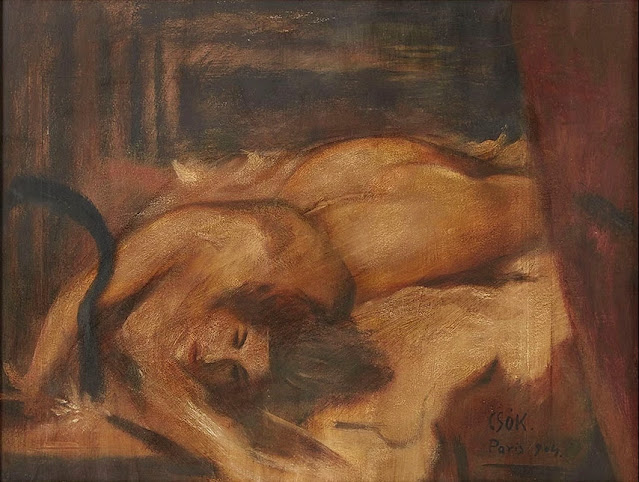Csok, Istvan (1865-1961)
Studio Interior, c. 1905
Oil on canvas
106 x 185 cm.
Hungarian National Gallery, Budapest
The first picture - shown here - was taken in 1905 (Above). The success of the picture at the time is clearly shown by the fact that Csók made several copies of the composition in many versions, some of its details can be seen again in his later pictures. A 1910 version is attached.
Csók István 1865-1961
Studio Corner (Painter and his Model)
Oil, wood
66x82 cm
Private collection
Csók István 1865-1961
Studio Corner (Painter and his Model)
Oil, wood
Private collection
Studio Corner (Painter and his Model)
Oil, wood
68×81 cm
Private collection
István Csók. Hungarian, (1865 - 1961)
Studio corner, late 1920's
Oil on Wood
Private collection
István Csók. Hungarian, (1865 - 1961)
Studio corner
Oil on Wood
Private collection
Istvan Csók
Nu allongé
Oil on cardboard
43 x 57,5 cm
Private collection
István Csók (13 February 1865, Sáregres – 1 February 1961) of Methuselah-like longevity, belonged to the generation of Hungarian artists who were now studying in their own country, at the Budapest College of Decorative Arts. The child of a well-to-do miller's family, he was a young man leading the carefree life of the Bohemian art student when he came up against the incomprehension surrounding Pál Szinyei Merse's return at the beginning of the 1880s. Since the vivid and exciting colouring of the near-Impressionistic style of the painter of Picnic in May was decidedly to his liking, he left the institution and went to Munich. At Simon Hollósy's private school he came into contact with the spirit of the new movement that was getting under way - naturalism. The products of his first period belong under that heading. He went to stay in Paris and then, after getting married, settled there from 1903 onwards: that was when he painted the pictures that teem with ever richer colours. After 1910, when he had returned to Hungary, his oeuvre took a new direction: the pictures he painted of his family and surroundings celebrate the joys of a balanced middle-class life. His art, which glorifies beauty, was increasingly revered; from 1920 he was the president of the Szinyei Society and between 1923 and 1933 he was a liberal-minded professor at the Academy of Fine Art. His portraits, nudes and still-lifes recall the mature Renoir, both in their cheerful colours and in their swirling brushstrokes. He contemplated the world with wise understanding, and was thus pensioned off by the conservative regime, but placed on a pedestal after 1945 by the new order; he was twice awarded the Kossuth Prize in the last period of his life.d to freeze to death in the snow. The original painting was destroyed in World War II. More on István Csók
Please visit my other blogs: Art Collector, Mythology, Marine Art, Portrait of a Lady, The Orientalist, Art of the Nude and The Canals of Venice, Middle East Artists, 365 Saints and 365 Days, also visit my Boards on Pinterest
Images are copyright of their respective owners, assignees or others.
Some Images may be subject to copyright
I don't own any of these images - credit is always given when due unless
it is unknown to me. if I post your images without your permission, please tell
me.
I do not sell art, art prints, framed posters or reproductions. Ads are
shown only to compensate the hosting expenses.
If you enjoyed this post, please share with friends and family.
Thank you for visiting my blog and also for liking its posts and pages.
Please note that the content of this post primarily consists of articles
available from Wikipedia or other free sources online.



.jpg)




.jpg)

No comments:
Post a Comment